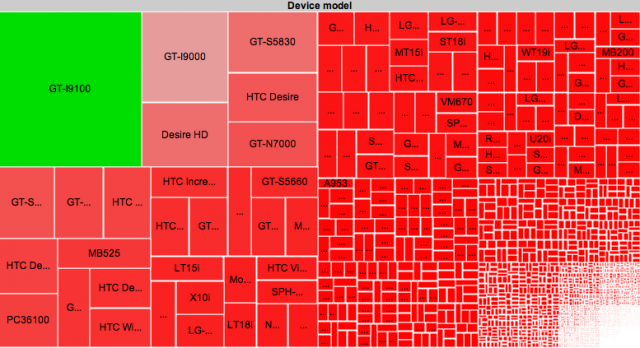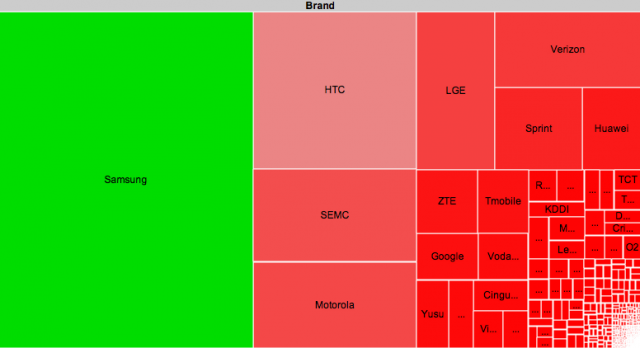Just how bad is Android fragmentation? Almost 4000 devices later, the Galaxy S II is still king

There is a saying in the Android developer community: get as many devices in your office as you can, because if it?s working on one it?s likely broken on another.
This story rings true in a dramatic post done by OpenSignalMaps, an Android app that measures signal strength to the closest cell tower. Due to the wide range of users who would download the app, they?ve been able to derive some pretty ridiculous data: there are nearly 4,000 devices in the Android community, with Samsung and HTC at the top of the heap. There are numerous devices entered only once in the database, but many of the popular devices are ones that are available in Canada: the Galaxy S II, HTC Sensation, Sony Ericsson Xperia arc, Galaxy Note, etc.
What does this mean for Android development? The number of different hardware configurations, screen sizes and resolutions, and different versions of Android floating around mean that some apps won?t work on specific hardware. We see app updates all the time for specific hardware: ?Fixed a bug on Samsung Galaxy S II? or ?Faster loading times on HTC Sensation.? There is no easy way to develop an Android app to work on every piece of hardware, especially when your app is graphic-intensive or relies on access to the camera.
OpenSignalMaps claims Google has done a great job trying to facilitate flexible app design with its latest SDK, specifically in the ?fragments? method. They note that in April 2011 90% of Android users were on 2.2 or 2.3, a much more manageable solution. Now, with the release of Honeycomb and Ice Cream Sandwich, that number is 75%, with 4.0.x taking a small chunk out of that big apple. The latest reports for May suggest that ICS is?loaded on over 7% of devices, and will likely climb higher this month as high-profile devices such as the Amaze and Galaxy S II X receive their updates.

The data also confirms what we all already knew: Samsung leads the Android pack, with HTC a distant second. Other manufacturers like Motorola, LG, Huawei and Sony are also in play here, but nearly 40% of Android devices have a Samsung logo on them.
The OpenSignalMaps guys come to this conclusion: developing on Android is difficult but rewarding, and having at least one high- and low-end Samsung and HTC device for testing is the key to success. That, and a lot of patience.
Source: OpenSignalMaps
Via: Parislemon
gavin degraw alec time 100 bob beckel anna paquin warren buffett 2012 nfl schedule
No comments:
Post a Comment
Note: Only a member of this blog may post a comment.